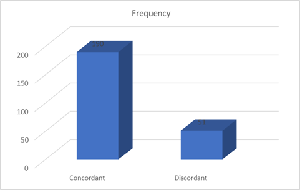Immunological and Virological Discordance in HIV-positive Patients on ART
Authors
##plugins.themes.bootstrap3.article.main##
Abstract
Objective: To evaluate CD4 count and viral load response post-antiretroviral therapy (ART), determine discordance incidence, and identify associated factors. Design: Analytical cross-sectional study using retrospective and prospective data from a tertiary hospital in Mumbai. Subjects/Patients: 241 HIV-positive individuals aged ≥12 years on ART for at least 6 months. Methods: CD4 counts and viral loads assessed at baseline and 6 months post-ART initiation. Data analyzed using SPSS v25; chi-square tests, bivariate, and multivariate logistic regression analyses performed (p<0.05 considered significant). Results: Immuno-virological discordance prevalence was 21.2%, comprising 15.8% immunological and 5.4% virological failures. Significant associations were found between discordance and age (p<0.05) and baseline CD4 count (p<0.05). Mean CD4 count improved from 323.29 cells/mm³ (±245.29) at baseline to 562.66 cells/mm³ (±270.99) at 6 months. Virological suppression (<1000 copies/ml) was achieved by over 90% of patients. Conclusion: ART was effective, marked by significant immune recovery and high virological suppression. The notable discordance prevalence underscores the necessity for standardized definitions and routine monitoring protocols. Significant associations of discordance with age and baseline CD4 count highlight the importance of early ART initiation and targeted management strategies.
##plugins.themes.bootstrap3.article.details##
Copyright (c) 2025 Shivaji Telang, Kavita Joshi, Kshitij Sonawale, Alhad Mulkalwar

This work is licensed under a Creative Commons Attribution 4.0 International License.
Creative Commons License All articles published in Annals of Medicine and Medical Sciences are licensed under a Creative Commons Attribution 4.0 International License.
[1] Schechter M, Tuboi SH. Discordant immunological and virological responses to antiretroviral therapy. J Antimicrob Chemother. 2006;58(3):506-10.
[2] Kelly C, Gaskell KM, Richardson M, Klein N, Garner P, MacPherson P. Discordant immune response with antiretroviral therapy in HIV-1: A systematic review of clinical outcomes. PLoS One. 2016;11(6):e0156099.
[3] Hailu GG, Wasihun AG. Immunological and virological discordance among people living with HIV on highly active antiretroviral therapy in Tigray, Northern Ethiopia. BMC Infect Dis. 2021;21(1):561.
[4] Manaye GA, Abateneh DD, Asmare WN, Abebe M. Factors associated with immunological and virological discordant responses to highly active antiretroviral therapy among adult HIV positive individuals in Ethiopia: A cross-sectional study. Medicine (Baltimore). 2021;100(47):e27624.
[5] Singh R, Maurya SP, Das N, Kabra SK, Lodha R, Das BK. Immunological factors associated with discordant virological response post-combination antiretroviral therapy in pediatric human immunodeficiency virus infection. Indian J Pharmacol. 2022;54(4):278-81.
[6] Kwakye-Nuako G, Mensah-Attipoe I, Arthur FN, et al. Diarrhoea-causing opportunistic pathogens associated with CD4 counts in HIV patients attending a tertiary hospital in Ghana. PLoS One. 2016;11(8):e0160735.
[7] Sainz T, Serrano-Villar S. HIV-associated immune dysfunction: Impact of aging and comorbidities. J Infect Dis. 2020;222(3):353-63.
[8] Appay V, Sauce D. Immune activation and inflammation in HIV-1 infection: causes and consequences. Nat Rev Immunol. 2008;8(7):529-38.
[9] Battegay M, Nüesch R, Hirschel B, Kaufmann GR. Immunological recovery and antiretroviral therapy in HIV-1 infection. Clin Infect Dis. 2006;43(5):677-83.
[10] Lundgren JD, Babiker AG, Gordin F, et al. Initiation of antiretroviral therapy in early asymptomatic HIV infection. N Engl J Med. 2015;373(9):795-807.

